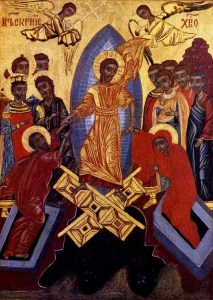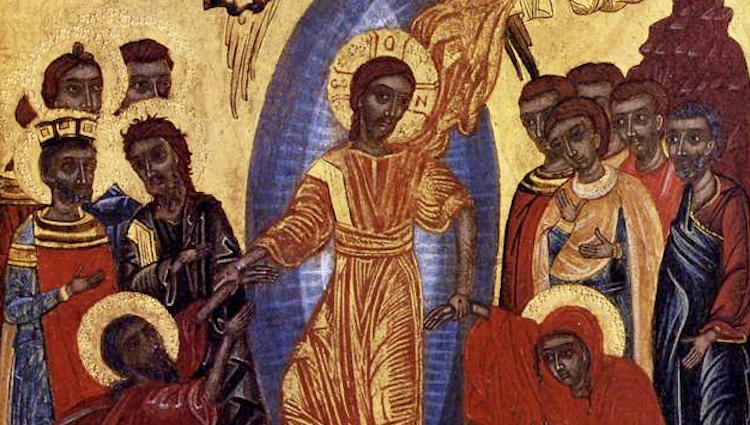Hymns are a major source of our imaginative conception of the Christian faith. A good hymn focuses our mind on a memorable cluster of images that illuminate doctrine, preparing us to celebrate the liturgy or providing a respite during it. While the great hymn writers have often taken scripture as their starting point, they have not been afraid to elaborate upon its images.
 Does the Christian faith thrive primarily on doctrine, or on a storehouse of images and associations? And where do those images and associations derive from?
Does the Christian faith thrive primarily on doctrine, or on a storehouse of images and associations? And where do those images and associations derive from?
The theologically-minded evoke the Incarnation, God dwelling in the midst of the world, as the source of Christian artistic creativity, certainly as far as visual image-making is concerned. But this was by no means preordained, and indeed had to be hard won; witness the iconoclastic controversy. Whether Christianity should embrace culture—i.e., the classical pagan culture—was a live issue in the early church. It was foreshadowed by St. Paul’s insistence that he preached the message of the Cross, not mere human eloquence. Three centuries later, St. Jerome felt an acute conflict between being a Christian and a Ciceronian. Yet Paul’s own letters are clothed in literary eloquence of their own. And as the church grew, more and more Christians realized the necessity of presenting a distinctive face to society through its way of life and the things it produced.
No one would deny that Christian faith is nourished by images and sense associations. Perhaps never is this more plain to us than at Eastertime. As the transformation of the Jewish Passover, and thus falling in the spring, it was inevitable that holiday should be brought within the orbit of the season’s natural rebirth. Our minds naturally associate Easter with the rejuvenation of nature, yet the textual source for these associations is not obvious; the Gospels draw no explicit link between the Resurrection and spring. The link came from the poetic imagination of early Christianity, baptizing the culture of paganism.
Today, in many of our churches on Easter Sunday we will hear some version of this ancient canticle:
Hail, thou festive, ever venerable day! Whereon
Hell is conquered and heaven is won by Christ.
There is a traditional Gregorian chant sung to the Latin text. But nowadays we often hear the poem rendered into lyrical English and accompanied by the triumphantly striding tune by Ralph Vaughan Williams:
Hail thee, festival day,
Blessed day that are hallowed forever
Day whereon Christ arose, breaking the kingdom of death.
More majestic perhaps is the Latin original:
Salve, festa dies, toto venerabilis aevo, qua Deus
Infernum vicit et astra tenet.
Translated literally, the verses declare that on this festive day God “conquered hell and took hold of the stars.” That refrain is repeated after each verse. The verses themselves provide a festival of vernal imagery.
For now the woods with their leaves and the
meadows with their flowers, pay homage to
Jesus’ triumph over the gloomy tomb.
Light, firmament, fields and sea, give justly
praise to the God that defeats the laws of death,
and rises above the stars.
The worship of nature was of course the keynote of pagan religion, and rituals of rebirth featured prominently. The author repurposes classical nature imagery in his paean to the Resurrection, thus making the mystery more attractive to our senses. All the mysterious movements of nature, which caused ancient man to wonder and rejoice, are given a new meaning. Yet such imagery surely enough has a precedent in the Psalms:
You visit the earth and water it,
you greatly enrich it…
You water its furrows abundantly,
settling its ridges,
softening it with showers,
and blessing its growth.
You crown the year with your bounty;
the tracks of your chariot overflow with richness.
The pastures of the wilderness drip,
the hills gird themselves with joy,
the meadows clothe themselves with flocks,
the valleys deck themselves with grain,
they shout and sing together for joy. (Psalm 65)
Later in Salve, festa dies the imagery of springtime is complemented by the imagery of baptism—clear flowing water and white clothing:
O King divine! Lo! Here a bright ray of thy
triumph—the souls made pure by the holy font.
The white-robed troop comes from the limpid
waters; and the old iniquity is cleansed in the new stream.
The white garments symbolize unspotted souls,
And the Shepherd rejoices in his snow-like flock.
The baptismal stream, snow-white garments, the shepherd and his flock. While delighting our senses, the author doesn’t neglect to nourish us with Christology and thus ensure a solid intellectual framework for his poem:
Seeing the human race was sunk in misery deep,
thou wast made Man, that thou mightiest rescue
man.
Nor wouldst thou be content to be born; but
being born in the flesh, in the same wouldst thou
suffer death.
Thou, the author of life and of all creation, wast
buried in the tomb, treading the path of death, to
give us salvation.
The poem returns to imagery with a dramatic chiaroscuro:
The gloomful bonds of hell were broken; the
abyss shook with fear, as the light shone upon its
brink.
The brightness of Christ put darkness to flight,
And made to fall the thick veils of everlasting night…
Show us once more thy face, that all ages may
See the light! Bring back the day which fled when
thou didst die.
The author of these verses, St. Venantius Fortunatus (c. 540 – c. 600, feast day December 14) demands a closer look. In the annals of Christianity and art, he was a notable synthesizer and pioneer. He was by no means the first Christian poet. The very idea that there could be such a thing as a Christian poet was owned by such earlier men as St. Ambrose, with his many hymns, and Aurelius Prudentius, often considered the first professional lay Christian poet and who wrote Psychomachia, considered the grandfather of all Christian poetic epics. This is the tradition Venantius inherited. He belongs to the extremely late Roman era, after it had fallen into the hands of Gothic kings. To pinpoint him precisely, he was born approximately a hundred years after the death of St. Augustine, who witnessed the fall firsthand and strove to interpret its meaning for Christian readers.
Much like Augustine or Boethius, Venantius is seen as a transitional figure between the classical and medieval worlds; he has even been described as the first troubadour. Historians have tried to piece together the outline of his life from the scant written record. We know he received a classical education at Ravenna, the Western imperial capital and cultural hub. He then traveled to France to become a poet to the aristocrats of the Frankish court. Venantius was ordained a priest and eventually became bishop of Poitiers. He had close associations with St. Gregory of Tours, the great bishop and historian, and with the Frankish queen Radegund.
St. Venantius seems to have been a man who enjoyed the legitimate pleasures of life to the fullest and wrote poems for all occasions: to praise his friends and patrons, to celebrate everyday experiences (one of his poems is about a basket of chestnuts, another praises black plums) and to honor the Christian mysteries. His hymns Vexilla regis prodeunt (“The Royal Banners Forward Go”) and Pange, lingua, gloriosi lauream certaminis (“Sing, My Tongue, the Glorious Battle”) are also Passiontide staples, the latter in turn inspiring St. Thomas Aquinas’ Pange, linga gloriosi corporis mysterium. His texts have been set to music by Palestrina, Bruckner, and Vaughan Williams, among others.
The Oxford Dictionary of Saints has it that Venantius “brought something of Roman elegance and literary culture to a barbarous Merovingian court” and that his hymns combine classical skill and Christian sentiment. Fortunately for Venantius, he did not have to invent Christian poetry from whole cloth. His predecessors St. Ambrose and Prudentius lay the groundwork. A historian of early Christianity, Robert Louis Wilken, says of Prudentius’ poetry that “the love of Christ and the love of the Muses embrace, as beauty of language and dignity of form become a vehicle befitting the story of God’s sojourn in this world.”
Thus, inspired by the reality of the Incarnation, Christians moved toward a solution and synthesis in the problem of Christ and culture. Christ, the Logos, would be the cornerstone of a new culture, not abolishing but fulfilling the old one. Old symbols would be given new and deeper meanings. Things of the senses would be not denied, but indeed intensified in this new system of belief. One could be an artist and a Christian, a poet and a Christian, a musician and a Christian. All these arts could assist in telling the story of Christ, the foundational epic of a new civilization.
Hymns are a major source of our imaginative conception of the Christian faith. A good hymn focuses our mind on a memorable cluster of images that illuminate doctrine, preparing us to celebrate the liturgy or providing a respite during it. While the great hymn writers have often taken scripture as their starting point, they have not been afraid to elaborate upon its images. In the case of the great Salve festa dies, one can’t help asking if it played a role in forming our imaginative conception of Easter. Passiontide commences amid the waving branches of Palm Sunday, amid the purple silk that veils the crucifix and other holy images, reflecting the defacement of Good by the powers of darkness.
When Easter bursts forth—subtly and stealthily, out of the dormant quietude of Holy Saturday—it is accompanied by shoots of white lilies, the fresh dew of the morning grass outside the Tomb, and the tentative buds that herald the Resurrection. The whole beautiful aura that we experience with our senses and imaginations was, arguably, first envisioned in the sixth century by one of Christianity’s finest lyricists.
This essay was first published here in April 2020.
The Imaginative Conservative applies the principle of appreciation to the discussion of culture and politics—we approach dialogue with magnanimity rather than with mere civility. Will you help us remain a refreshing oasis in the increasingly contentious arena of modern discourse? Please consider donating now.
The featured image is “The Resurrection of Christ” and is in the public domain, courtesy of Wikimedia Commons.


